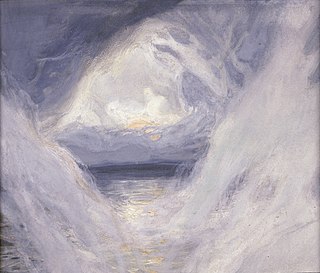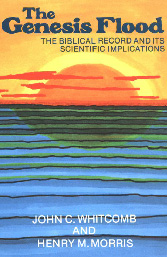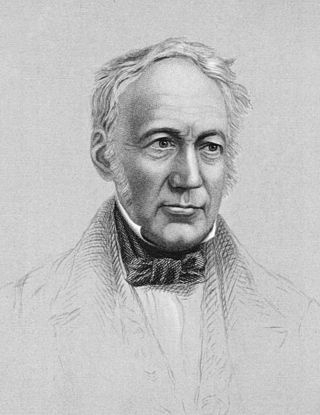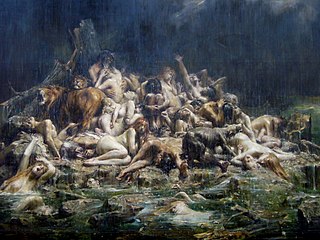Related Research Articles

Creation science or scientific creationism is a pseudoscientific form of Young Earth creationism which claims to offer scientific arguments for certain literalist and inerrantist interpretations of the Bible. It is often presented without overt faith-based language, but instead relies on reinterpreting scientific results to argue that various myths in the Book of Genesis and other select biblical passages are scientifically valid. The most commonly advanced ideas of creation science include special creation based on the Genesis creation narrative and flood geology based on the Genesis flood narrative. Creationists also claim they can disprove or reexplain a variety of scientific facts, theories and paradigms of geology, cosmology, biological evolution, archaeology, history, and linguistics using creation science. Creation science was foundational to intelligent design.

In geology, catastrophism is the theory that the Earth has largely been shaped by sudden, short-lived, violent events, possibly worldwide in scope. This contrasts with uniformitarianism, according to which slow incremental changes, such as erosion, brought about all the Earth's geological features. The proponents of uniformitarianism held that the present was "the key to the past", and that all geological processes throughout the past resembled those that can be observed today. Since the 19th-century disputes between catastrophists and uniformitarians, a more inclusive and integrated view of geologic events has developed, in which the scientific consensus accepts that some catastrophic events occurred in the geologic past, but regards these as explicable as extreme examples of natural processes which can occur.

Young Earth creationism (YEC) is a form of creationism which holds as a central tenet that the Earth and its lifeforms were created by supernatural acts of the Abrahamic God between about 6,000 and 10,000 years ago. In its most widespread version, YEC is based on the religious belief in the inerrancy of certain literal interpretations of the Book of Genesis. Its primary adherents are Christians and Jews who believe that God created the Earth in six literal days.

Old Earth Creationism (OEC) is an umbrella of theological views encompassing certain varieties of creationism which may or can include day-age creationism, gap creationism, progressive creationism, and sometimes theistic evolution.

The antediluvian period is the time period chronicled in the Bible between the fall of man and the Genesis flood narrative in biblical cosmology. The term was coined by Thomas Browne. The narrative takes up chapters 1–6 of the Book of Genesis. The term found its way into early geology and science until the late Victorian era. Colloquially, the term is used to refer to any ancient and murky period.

Day-age creationism, a type of old Earth creationism, is an interpretation of the creation accounts in Genesis. It holds that the six days referred to in the Genesis account of creation are not literal 24-hour days, but are much longer periods. The Genesis account is then reconciled with the age of the Earth. Proponents of the day-age theory can be found among both theistic evolutionists, who accept the scientific consensus on evolution, and progressive creationists, who reject it. The theories are said to be built on the understanding that the Hebrew word yom is also used to refer to a time period, with a beginning and an end and not necessarily that of a 24-hour day.

Flood geology is a pseudoscientific attempt to interpret and reconcile geological features of the Earth in accordance with a literal belief in the Genesis flood narrative, the flood myth in the Hebrew Bible. In the early 19th century, diluvial geologists hypothesized that specific surface features provided evidence of a worldwide flood which had followed earlier geological eras; after further investigation they agreed that these features resulted from local floods or from glaciers. In the 20th century, young-Earth creationists revived flood geology as an overarching concept in their opposition to evolution, assuming a recent six-day Creation and cataclysmic geological changes during the biblical flood, and incorporating creationist explanations of the sequences of rock strata.

Gap creationism is a form of old Earth creationism that posits that the six-yom creation period, as described in the Book of Genesis, involved six literal 24-hour days, but that there was a gap of time between two distinct creations in the first and the second verses of Genesis, which the theory states explains many scientific observations, including the age of the Earth. It differs from day-age creationism, which posits that the 'days' of creation were much longer periods, and from young Earth creationism, which although it agrees concerning the six literal 24-hour days of creation, does not posit any gap of time.

Progressive creationism is the religious belief that God created new forms of life gradually over a period of hundreds of millions of years. As a form of old Earth creationism, it accepts mainstream geological and cosmological estimates for the age of the Earth, some tenets of biology such as microevolution as well as archaeology to make its case. In this view creation occurred in rapid bursts in which all "kinds" of plants and animals appear in stages lasting millions of years. The bursts are followed by periods of stasis or equilibrium to accommodate new arrivals. These bursts represent instances of God creating new types of organisms by divine intervention. As viewed from the archaeological record, progressive creationism holds that "species do not gradually appear by the steady transformation of its ancestors; [but] appear all at once and "fully formed."

The history of creationism relates to the history of thought based on the premise that the natural universe had a beginning, and came into being supernaturally. The term creationism in its broad sense covers a wide range of views and interpretations, and was not in common use before the late 19th century. Throughout recorded history, many people have viewed the universe as a created entity. Many ancient historical accounts from around the world refer to or imply a creation of the earth and universe. Although specific historical understandings of creationism have used varying degrees of empirical, spiritual and/or philosophical investigations, they are all based on the view that the universe was created. The Genesis creation narrative has provided a basic framework for Jewish and Christian epistemological understandings of how the universe came into being – through the divine intervention of the god, Yahweh. Historically, literal interpretations of this narrative were more dominant than allegorical ones.

The Creation Research Society (CRS) is a Christian fundamentalist group that requires of its members belief that the Bible is historically and scientifically true in the original autographs, belief that "original created kinds" of all living things were created during the Creation week described in Genesis, and belief in flood geology.

The Genesis Flood: The Biblical Record and its Scientific Implications is a 1961 book by young Earth creationists John C. Whitcomb and Henry M. Morris that, according to historian Ronald Numbers, elevated young Earth creationism "to a position of fundamentalist orthodoxy".

Andrew Ure FRS was a Scottish physician, chemist, scriptural geologist, and early business theorist who founded the Garnet Hill Observatory. He was a fellow of the Royal Astronomical Society and the Royal Society. Ure published a number of books based on his industrial consulting experiences.

Granville Penn was a great-grandson of Admiral Sir William Penn, a British author, and scriptural geologist.

The International Conference on Creationism (ICC) is a conference in support of young earth creationism, sponsored by the Creation Science Fellowship (CSF). The first conference occurred in 1986 at Duquesne University in Pittsburgh. Subsequent conferences have been held in 1990, 1994, 1998, 2003, 2008, 2013 and 2018.

George Bugg (1769–1851) was an Anglican deacon and curate for several churches in England and a scriptural geologist who wrote a two volume book called Scriptural Geology.
George Fairholme (1789–1846) was a land owner, banker, traveller, naturalist and scriptural geologist, born in Lugate, Midlothian, Scotland on 15 January 1789.

The Genesis flood narrative is a Hebrew flood myth. It tells of God's decision to return the universe to its pre-creation state of watery chaos and remake it through the microcosm of Noah's ark.
James Mellor Brown (1796–1867) was a British cleric, known as a scriptural geologist.

The local flood theory is an interpretation of the Genesis flood narrative where the flood of Noah is interpreted as a local event, generally located in Mesopotamia, instead of a global event.
References
- Books
- Brooke, John Hedley; Cantor, G. N. (2000). Reconstructing nature: the engagement of science and religion. Oxford University Press. ISBN 0-19-513706-X.
- Clark, John (1970). The Life and Letters of the Reverend Adam Sedgwick. Westmead: Gregg International Publishers. p. 362. ISBN 0-576-29117-X.
- Clifford, David (2006). Repositioning Victorian Sciences: Shifting Centres in Nineteenth-Century Thinking. City: Anthem Press. ISBN 1-84331-212-3.
- Cole, Henry (1834). Popular Geology Subversive of Divine Revelation. pp. 52, 113.
- Gillispie, C. C. (1996). Genesis and Geology. London: Harvard University Press. ISBN 0-674-34481-2.
- Khun, Thomas S. (1970). The Structure of Scientific Revolutions. p. 76.
- Livingstone, David; Hart, Darryl G.; Noll, Mark A. (1999). Evangelicals and Science in Historical Perspective. Oxford University Press. ISBN 0-19-511557-0.
- McCalla, A. (2006). The creationist debate: the encounter between the Bible and the historical mind . T & T Clark International. p. 65. ISBN 0-8264-6447-5.
- Piccardi, L.; Masse, W. Bruce (2007). Myth and Geology . London: Geological Society. p. 46. ISBN 978-1-86239-216-8.
- Rudwick, Martin J. S. (1988). The Great Devonian Controversy . Springer. pp. 42–44. ISBN 0-226-73102-2.
- Rupke, Nicolaas (1983). The Great Chain of History. Oxford: Clarendon Press. pp. 42–50. ISBN 0-19-822907-0.
- Young, Davis A. (1995). The Biblical Flood: a case study of the Church's response to extrabiblical evidence. Grand Rapids, Mich: Eerdmans. p. 340. ISBN 0-8028-0719-4. – History of the Collapse of Flood Geology and a Young Earth, adapted from the book.
- Young, Davis A.; Stearley, Ralph F. (2008). The Bible, rocks, and time : geological evidence for the age of the earth. Downers Grove, Ill.: IVP Academic. ISBN 978-0-8308-2876-0.
- Journals
- Lyell, Charles (1827). "Review of Scrope's Memoir on the Geology of Central France". Quarterly Review. XXXVI (72): 480.
- Miller, Hugh (1857). The Testimony of the Rocks. pp. 367–68.
- Millhauser, Milton (1954). "The Scriptural Geologists: An Episode in the History of Opinion". Osiris. 11 (1). Saint Catherines Press: 65–86. doi:10.1086/368571. JSTOR 301663. S2CID 144093595.
- O'Connor, Ralph (2007). "Young-Earth Creationists in Early Nineteenth-century Britain? Towards a reassessment of 'Scriptural Geology'" (PDF). History of Science. 45 (150). Science History Publications Ltd: 357–403. doi:10.1177/007327530704500401. ISSN 0073-2753. S2CID 146768279.
- Rudwick, Martin J. S. (2008). Worlds before Adam. University of Chicago Press. p. 84. ISBN 978-0-226-73128-5.
- Russell, Colin A. (1989). "The Conflict Metaphor and its Social Origins". Science and Christian Belief. 1 (1): 25.
- Simpson, Martin (1884). The Fossils of the Yorkshire Lias Described from Nature. ISBN 9781407739052.
- Sedgwick, Adam (1830). "Annual General Meeting of the Geological Society, Presidential address". Philosophical Magazine. Series 2. VII (40): 310.
- Sedgwick, Adam (1834). Discourse (second ed.). Cambridge, Pitt Press. pp. 148–153.
- Wood, Paul (2004). Science and Dissent in England, 1688-1945. Aldershot: Ashgate. ISBN 0-7546-3718-2.